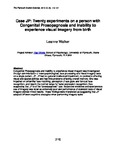Case JP: Twenty experiments on a person with Congenital Prosopagnosia and inability to experience visual imagery from birth
| dc.contributor.author | Walker, L. | |
| dc.date.accessioned | 2019-05-13T15:54:40Z | |
| dc.date.available | 2019-05-13T15:54:40Z | |
| dc.date.issued | 2010 | |
| dc.identifier.citation |
Walker, L. (2010) 'Case JP: Twenty experiments on a person with Congenital Prosopagnosia and inability to experience visual imagery from birth', The Plymouth Student Scientist, p. 113-141. | en_US |
| dc.identifier.issn | 1754-2383 | |
| dc.identifier.uri | http://hdl.handle.net/10026.1/13915 | |
| dc.description.abstract |
Congenital Prosopagnosia and inability to experience visual imagery was investigated through administration of neuropsychological, face processing and visual imagery tests on a single patient, JP. JP had no general intellectual impairment, no problems affecting visual and spatial abilities and had little problems affecting overall memory. She was impaired on unfamiliar face matching, perception of eye gaze and famous face recognition, and was in the normal range for facial expression recognition; thus suggesting that JP is of the “prosopagnosic” type. Subjective vividness and spontaneous use of imagery was rated as extremely poor and performance of standard tests of visual imagery yielded mixed results. These findings were interpreted as suggesting that JP adopted different cognitive strategies when performing imagery tasks. | en_US |
| dc.language.iso | en | en_US |
| dc.publisher | University of Plymouth | |
| dc.rights | Attribution 3.0 United States | * |
| dc.rights.uri | http://creativecommons.org/licenses/by/3.0/us/ | * |
| dc.subject | Congenital Prosopagnosia | en_US |
| dc.subject | visual imagery | en_US |
| dc.subject | neuropsychological | en_US |
| dc.subject | face processing | en_US |
| dc.subject | prosopagnosic | en_US |
| dc.title | Case JP: Twenty experiments on a person with Congenital Prosopagnosia and inability to experience visual imagery from birth | en_US |
| dc.type | Article | |
| plymouth.issue | 2 | |
| plymouth.volume | 3 | |
| plymouth.journal | The Plymouth Student Scientist |



